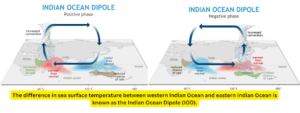About the Indian Ocean Dipole (IOD):

- The IOD is a coupled ocean-atmosphere event that occurs in the equatorial Indian Ocean.
- Positive IOD: The western side of the Indian Ocean (near the Somalia coast) becomes warmer than the eastern Indian Ocean(near the Indonesian and Malaysian coastline)–helps rainfall along the African coastline and also over the Indian subcontinent.
- Negative IOD: When there is a negative dipole event, warmer water gathers in the eastern Indian Ocean, and moist air moves in the direction of Australia.
Indian Ocean Dipole and El Nino:
Normal Year: In a normal year, warmer waters in the western Pacific near Indonesia cross over into the Indian Ocean and make that part of the Indian Ocean slightly warmer. That causes the air to rise and helps the prevailing air circulation.
Many studies suggest that IOD events are actually induced by ENSO. (Argument in favor)
- El Nino and IOD: A positive IOD event is often seen developing at times of an El Nino, while a negative IOD is sometimes associated with La Nina.
- During El Nino, the Pacific side of Indonesia is cooler than normal because of which the Indian Ocean side also gets cooler. This helps the development of a positive IOD.
The argument against above connection:
(However according to some scholars: there is evidence to show that IOD events can have an independent existence.)
- While external factors such as ENSO can trigger IOD in some cases, the phenomenon, many times, is caused by local circulations or subsurface processes within the equatorial Indian Ocean.
- Interestingly, when both IOD and ENSO are strong, their circulation patterns can impact each other.
- Studies suggest that–Compared to ENSO events, the impacts of IODs are much weaker.
Why in news?
- A positive IOD has an 80% chance of occurring during the June–August 2023 season, according to the India Meteorological Department (IMD).
 Profile
Profile Settings
Settings Refer your friends
Refer your friends Sign out
Sign out






